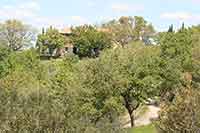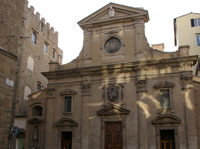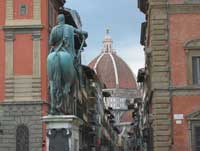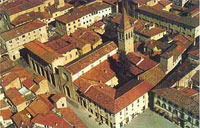| |
|
| |
|
|
|
|
|
|
| |
 |
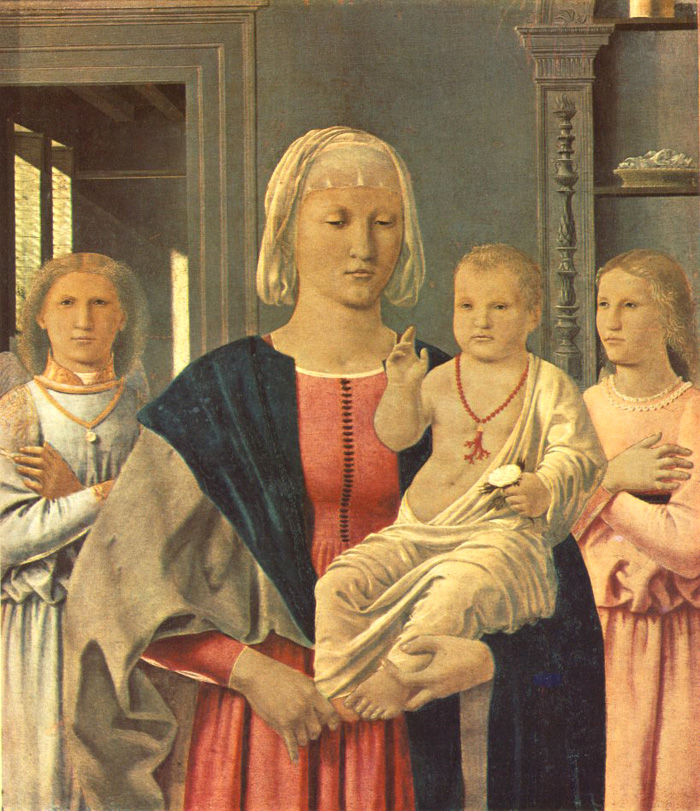 |
Piero della Francesca, Madonna di Senigallia, oil on panel, 67 cm × 53.5 cm (26 in × 21.1 in), Galleria Nazionale delle Marche, Urbino
|
|
 |
|
| |
|
|
|
| |
|
Piero della Francesca | Madonna di Senigallia (1478-1480)
|
|
|
|
| |
|
The Madonna di Senigallia is a painting by the Italian Renaissance master Piero della Francesca, finished around 1474. It is housed in the Galleria Nazionale delle Marche, in the Ducal Palace of Urbino.
The painting was originally in the church of Santa Maria delle Grazie of Senigallia (Le Marche), whence the current name.[1]
The 1950s restoration showed the high quality of Piero della Francesca's treatment of light, as well as the influence of Flemish masters on it in details such as the basket with linen gauze, the coral and the fabric covering the Madonna's head. The light, which realistically enters from the window on the left, is a symbol of the Virgin's conception. The linen in the basket is instead an allusion to her purity, while the case for hosts in the shelf and the coral hanging from Jesus' necklace both hint to the Eucharist sacrifice. The staring, thoughtful immobility of all the characters would be also an allusion to the latter.
The painting is quite different from Piero's previous production. The faces still have an expression of aloofness and of superior rational wisdom, but they also convey a sense of precious, almost exotic, beauty. This is one of the paintings in which the artist most clearly reveals his interst in light values, both in terms of reflections and of magical transparencies. From Mary's veil, slightly puckered on her forehead with subtle light variations, to the coral necklace around the Child's neck, to the angels' shining pearls - these are all effects which, together with the light streaming in from the window, and forming a perfectly geometrical shape on the end wall, will appear again and again in Dutch painting of the 17th century.
The blond hair of the angel on the left, because of the reflection of the light coming in from behind, acquires an almost magical golden glow, as though it were a natural halo.
|
 |
Piero della Francesca, Madonna di Senigallia, oil on panel, 67 cm × 53.5 cm (26 in × 21.1 in), Galleria Nazionale delle Marche, Urbino
|
The painting has risen in art historians' evaluations ever since it was cleaned and restored to reveal much of its previously hidden beauty (PI. X). It was first noted in the church of Santa Maria della Grazia just outside Senigallia, but this church was constructed at about the time of Piero's death so certainly it was not the image's original intended site. In addition, the fact that Piero placed the Madonna and Child in a domestic setting suggests that its placement in this church occurred much later. The painting's early life remains a mystery: there are no documents relating to it prior to 1822, when one of its discoverers noted it as "so beautiful, so true, so studied that one is not able to desire more."
In spite of its lack of documentation before the early nineteenth century, the Madonna and Child has been linked to the Montefeltro. As discussed above, in 1474 Pope Sixtus IV and Federico had arranged the marriage of Giovanna, Federico's daughter, and Giovanni della Rovere, the Pope's nephew. This alliance brought Federico his title of Duke, and Federico ceded Senigallia to Giovanni della Rovere, who thereafter ruled the town. The political arrangements were made when Giovanna was fourteen years of age, so the marriage ceremonies only followed in 1478. The painting has been linked to this political alliance and Giovanna's transfer to Senigallia with the date of commission and painting placed variously between the dates of the alliance and the marriage.
Because Piero was in Sansepolcro from 1472 to early 1475 and from 1477 to the summer of 1481, we can state with a high degree of certainty that Piero painted the Senigallia Madonna in the years 1475-76.6 These dates would strengthen the frequent suggestion that Federico commissioned the painting as a gift to the couple. In addition, another link between the young couple and the painting has been suggested. The angel in bluegray on the left is much more masculine in appearance than Piero's traditional asexual angels, whereas the angel on the right is more feminine. This has led to the claim that the two angels represent the groom and bride of 1478.' [2]
|
| |
|
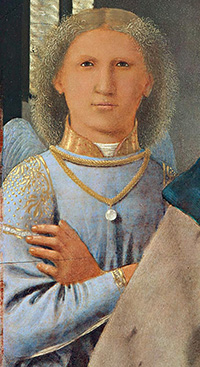 |
|
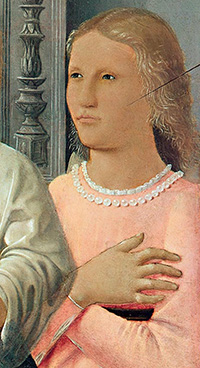 |
| |
|
Piero della Francesca, Madonna di Senigallia, details, Galleria Nazionale delle Marche, Urbino. The two angels probably represent the groom and bride who married in 1478, Giovanni della Rovere and Federico da Montefeltro's daughter Giovanna. |

James R. Banker, Piero della Francesca Artist and Man, p 168, Oxford (2014), ISBN: 9780199609314
Art in Tuscany | Giorgio Vasari's Lives of the Artists | Piero della Francesca
Art in Tuscany | Piero della Francesca in central Italy, an itinerary full of artistic and historical beauty
|
|
|
|
| |
|

|
|
| |
|
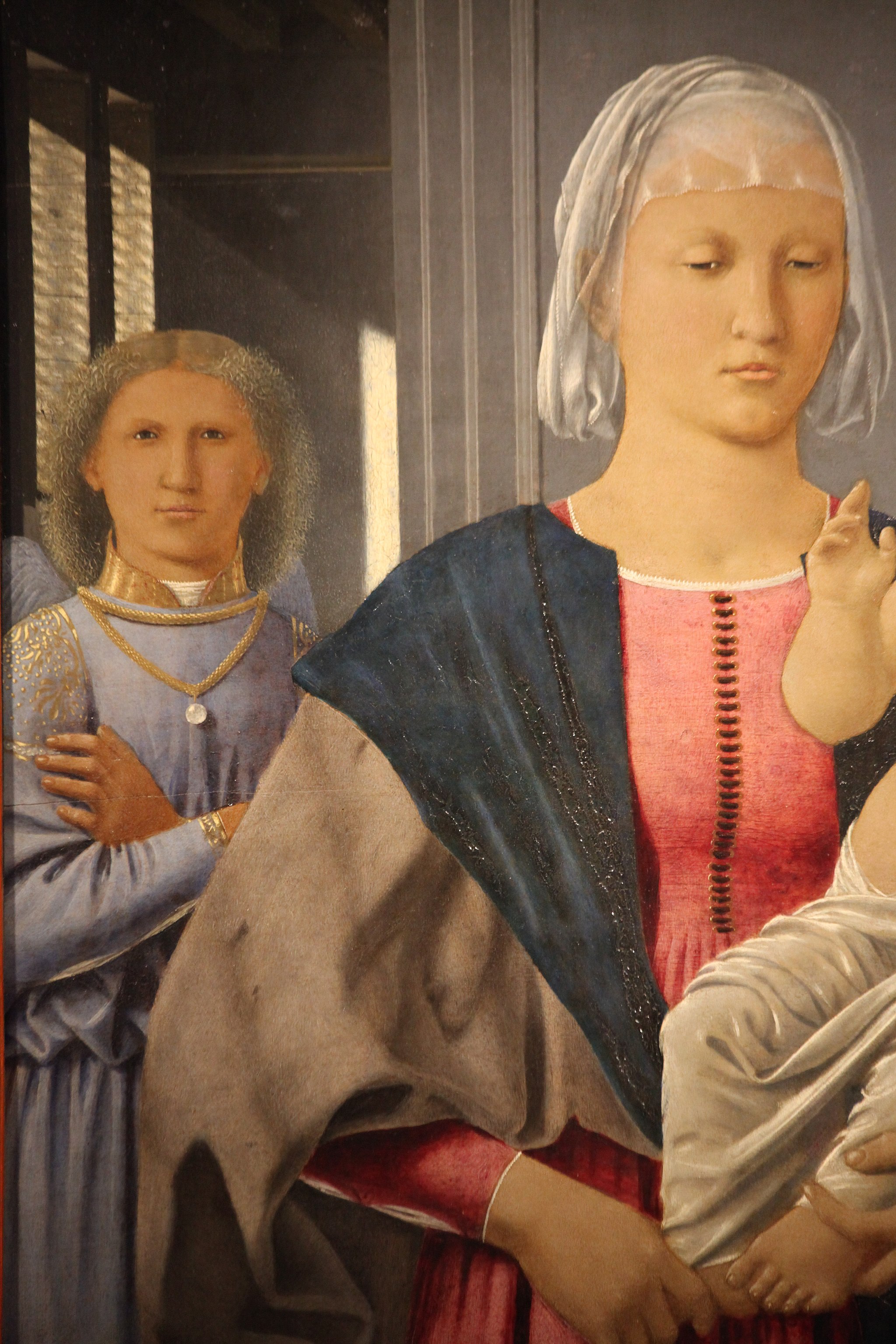 |
|
 |
|
 |
| |
|
|
|
|
| |
|
|
|
|
 |
|
 |
|
|
Piero della Francesca, Madonna di Senigallia, details, Galleria Nazionale delle Marche, Urbino
|
|
|
|
|
| |
|
| |
|
This article incorporates material from the Wikipedia articles Piero della Francesca, Madonna di Senigallia, and Palazzo Ducale, Urbino, published under the GNU Free Documentation License.
Wikimedia Commons has media related to Piero della Francesca.
|
In the footsteps of Piero della Francesca
|
|
Itinerary in Tuscany| Starting from Sansepolcro, his hometown, follow this itinerary, and see his greatest work of Piero della Francesca in Sansepolcro, Perugia, Urbino, Arezzo, Rimini and eventually Florence.
Itinerary in Central Italy | In the footsteps of Piero della Francesca



Holiday accomodation in Tuscany | Podere Santa Pia | Artist and writer's residency
|
| |
|
|
|
|

. |
|
|
Podere Santa Pia |
|
Podere Santa Pia, garden view, April |
|
View from Podere Santa Pia
on the Maremma hills |
| |
|
|
|
|
|
|
|
|
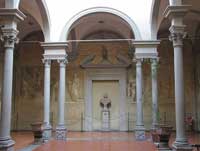
|
Santa Trinita Florence |
|
Piazza della Santissima Annunziata
in Florence |
|
Choistro dello Scalzo, Florence |
| |
|
|
|
|
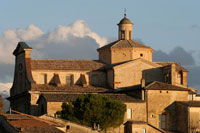
|
|
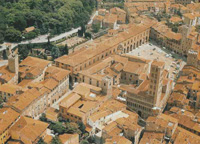
|
|
|
Montefalco |
|
Arezzo |
|
Sansepolcro |
| |
|
|
|
|
Urbino | Galleria Nazionale delle Marche
|
|
|
The small hill town of Urbino, in the Marche, experienced a great cultural flowering in the 15th century, attracting artists and scholars from all over Italy and beyond, and influencing cultural developments elsewhere in Europe. Urbino is the hometown of Raphael and architect Donato Bramante, but the town owes much of its fame to the Duke of Montefeltro. This mercenary general turned Urbino into an important Renaissance center, attracting artists such as Piero della Francesca, Paolo Uccello and Giovanni Santi.
The Ducal Palace is one of the most important monuments in Italy andis listed as UNESCO World Heritage Site. The construction of the Ducal Palace was begun for Duke Federico III da Montefeltro around the mid-fifteenth century by the Florentine Maso di Bartolomeo. The new construction included the pre-existing Palace of the Jole. Luciano Laurana, an architect from Dalmatia who had been influenced by Brunelleschi's cloisters in Florence, designed the façade, the famous courtyard and the great entrance staircase. Laurana's light and noble arcaded courtyard at Urbino rivals that of the Palazzo della Cancelleria in Rome as the finest of the Renaissance. Overcoming the exigencies of the clifflike site, which made an irregular massing of architecture necessary, from the 1460s onwards Laurana created what contemporaries considered the ideal princely dwelling. Many of the refined Early Renaissance carved details are so similar to features in paintings by Piero della Francesca that scholars have debated his possible input in the execution of Laurana's plan.
After Laurana's departure from Urbino in 1472, works were continued by Francesco di Giorgio Martini, who was mainly responsible for the façade decoration.
The Galleria Nazionale delle Marche (National Gallery of the Marche), housed in the palace, is one of the most important collection of Renaissance art in the world. It includes important works by artists such as Santi, Van Wassenhove (a Last Supper with portraits of the Montefeltro family and the court), Melozzo da Forlì, Raphael, Piero della Francesca (with the famous Flagellation), Paolo Uccello, Timoteo Viti, and other 15th century artists, as well as a late Resurrection by Titian.
|

[1] The picture is first mentioned in 1822, by Luigi Pungileoni in a letter to the Marchese Raimondo Antaldi, when it was in a chapel of the church of Santa Maria delle Grazie in Senigallia. (Keith Christiansen, Piero della Francesca: Personal Encounters, Metropolitan Museum of Art, 13 jan. 2014
[2] James R. Banker, Piero della Francesca Artist and Man, p 168, Oxford (2014), ISBN: 9780199609314
For a detailed history of the picture and its association with Giovanni della Revere as well as informanon relating to its conservation and technique, see also the various contributions in La luce e il mistero: La Madonna di Senigallia nella sua città; il capolavoro di Piero della Francesca dopo il restauro, ed. Gabrielle Barucca,, ed. Gabrielle Barucca, exh. cat., Rocca Roveresca, Senigallia (Ancona, 2011). |
|
|
| |
|
|
|
| |
|
|
|
| |
|
|
|
| |
|
|
|
| |
|
|
|
| |
|
|
|
![]()










